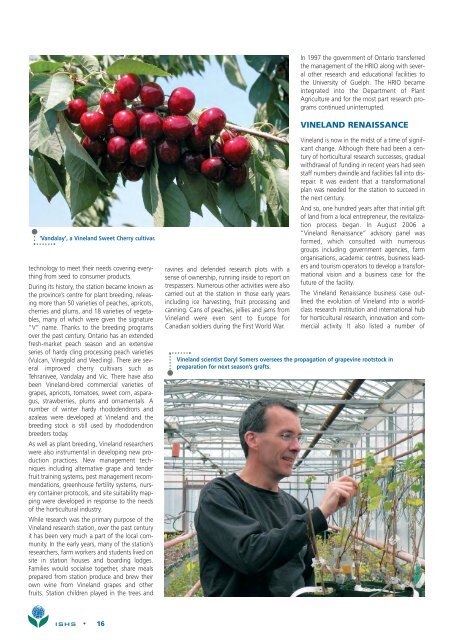Chronica Horticulturae volume 49 number 2 ... - Acta Horticulturae
Chronica Horticulturae volume 49 number 2 ... - Acta Horticulturae
Chronica Horticulturae volume 49 number 2 ... - Acta Horticulturae
Create successful ePaper yourself
Turn your PDF publications into a flip-book with our unique Google optimized e-Paper software.
In 1997 the government of Ontario transferred<br />
the management of the HRIO along with several<br />
other research and educational facilities to<br />
the University of Guelph. The HRIO became<br />
integrated into the Department of Plant<br />
Agriculture and for the most part research programs<br />
continued uninterrupted.<br />
VINELAND RENAISSANCE<br />
‘Vandalay’, a Vineland Sweet Cherry cultivar.<br />
technology to meet their needs covering everything<br />
from seed to consumer products.<br />
During its history, the station became known as<br />
the province’s centre for plant breeding, releasing<br />
more than 50 varieties of peaches, apricots,<br />
cherries and plums, and 18 varieties of vegetables,<br />
many of which were given the signature<br />
“V” name. Thanks to the breeding programs<br />
over the past century, Ontario has an extended<br />
fresh-market peach season and an extensive<br />
series of hardy cling processing peach varieties<br />
(Vulcan, Vinegold and Veecling). There are several<br />
improved cherry cultivars such as<br />
Tehranivee, Vandalay and Vic. There have also<br />
been Vineland-bred commercial varieties of<br />
grapes, apricots, tomatoes, sweet corn, asparagus,<br />
strawberries, plums and ornamentals. A<br />
<strong>number</strong> of winter hardy rhododendrons and<br />
azaleas were developed at Vineland and the<br />
breeding stock is still used by rhododendron<br />
breeders today.<br />
As well as plant breeding, Vineland researchers<br />
were also instrumental in developing new production<br />
practices. New management techniques<br />
including alternative grape and tender<br />
fruit training systems, pest management recommendations,<br />
greenhouse fertility systems, nursery<br />
container protocols, and site suitability mapping<br />
were developed in response to the needs<br />
of the horticultural industry.<br />
While research was the primary purpose of the<br />
Vineland research station, over the past century<br />
it has been very much a part of the local community.<br />
In the early years, many of the station’s<br />
researchers, farm workers and students lived on<br />
site in station houses and boarding lodges.<br />
Families would socialise together, share meals<br />
prepared from station produce and brew their<br />
own wine from Vineland grapes and other<br />
fruits. Station children played in the trees and<br />
ravines and defended research plots with a<br />
sense of ownership, running inside to report on<br />
trespassers. Numerous other activities were also<br />
carried out at the station in those early years<br />
including ice harvesting, fruit processing and<br />
canning. Cans of peaches, jellies and jams from<br />
Vineland were even sent to Europe for<br />
Canadian soldiers during the First World War.<br />
Vineland is now in the midst of a time of significant<br />
change. Although there had been a century<br />
of horticultural research successes, gradual<br />
withdrawal of funding in recent years had seen<br />
staff <strong>number</strong>s dwindle and facilities fall into disrepair.<br />
It was evident that a transformational<br />
plan was needed for the station to succeed in<br />
the next century.<br />
And so, one hundred years after that initial gift<br />
of land from a local entrepreneur, the revitalization<br />
process began. In August 2006 a<br />
“Vineland Renaissance” advisory panel was<br />
formed, which consulted with numerous<br />
groups including government agencies, farm<br />
organisations, academic centres, business leaders<br />
and tourism operators to develop a transformational<br />
vision and a business case for the<br />
future of the facility.<br />
The Vineland Renaissance business case outlined<br />
the evolution of Vineland into a worldclass<br />
research institution and international hub<br />
for horticultural research, innovation and commercial<br />
activity. It also listed a <strong>number</strong> of<br />
Vineland scientist Daryl Somers oversees the propagation of grapevine rootstock in<br />
preparation for next season’s grafts.<br />
ISHS • 16
















